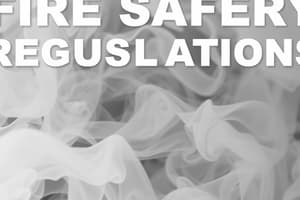Podcast
Questions and Answers
What determines the direction of fire travel?
What determines the direction of fire travel?
- Occupancy type
- Ventilation
- Fire location
- Basic chemistry and physics of fire (correct)
What is the importance of pre-incident planning?
What is the importance of pre-incident planning?
- It determines the number of occupants
- It helps estimate the fuel load
- It identifies the location of fire
- It provides information on ventilation possibilities (correct)
What is the purpose of a defend-in-place strategy?
What is the purpose of a defend-in-place strategy?
- To save occupants from a fire (correct)
- To evacuate occupants from a building
- To report to the fire department
- To provide an area of refuge for immobile occupants
What is the significance of ventilation during a fire emergency?
What is the significance of ventilation during a fire emergency?
Which type of smoke indicates a high probability of saving occupants?
Which type of smoke indicates a high probability of saving occupants?
What is the critical indicator at a structure fire?
What is the critical indicator at a structure fire?
What is the purpose of an occupant accountability system?
What is the purpose of an occupant accountability system?
What is the importance of understanding smoke and fire movement?
What is the importance of understanding smoke and fire movement?
What is the significance of hidden or ventilation-limited fires?
What is the significance of hidden or ventilation-limited fires?
What is the importance of evacuation status during a fire emergency?
What is the importance of evacuation status during a fire emergency?
What is the requirement for primary and secondary schools during a fire emergency?
What is the requirement for primary and secondary schools during a fire emergency?
What should firefighters know about areas of refuge during a fire emergency?
What should firefighters know about areas of refuge during a fire emergency?
Flashcards are hidden until you start studying
Study Notes
- Smoke and fire conditions are important factors in occupant and firefighter safety.
- Heavy, dark, pressurized smoke and visible fire may require a defensive attack.
- Light smoke with no fire evident indicates a high probability of saving occupants.
- Hidden or ventilation-limited fires can rapidly increase when they receive additional air.
- Flashover is a critical indicator at a structure fire.
- Fire location determines the method and direction of attack.
- Basic chemistry and physics of fire determine the direction of fire travel.
- Ventilation, intentional or unintentional, may change the direction of smoke and fire travel.
- Ventilation is a key factor during all phases of the operation.
- Understanding smoke and fire movement is essential to good venting.
- Preincident planning can provide information on ventilation possibilities, aerial apparatus positioning, and occupancy type.
- Knowing the building's use can determine the number of occupants, fuel load, and value of contents.
- Estimating the number of occupants is based on the building's intended use and occupancy load per square foot.
- Evacuation status considers occupant proximity to fire, awareness, mobility, familiarity with the building, primary and alternative egress routes, and medical status.
- Primary and secondary schools are required to conduct fire drills and account for occupants.
- Preplanned buildings should have an occupant accountability system to report to the fire department and where occupants will be assembled.
- Occupant proximity to fire places them in imminent danger.
- Awareness of occupants is related to occupancy type.
- Mobility of occupants and their familiarity with the building affect their ability to evacuate.
- Primary and alternative egress routes are essential for occupants to escape unassisted.
- Hospitals should have a defend-in-place strategy for occupants.
- Public buildings may have areas of refuge for immobile occupants.
- Pre-incident plans should address special facilities like areas of refuge.
- Firefighters must know the location and capacity of areas of refuge.
- Building managers should communicate their expectations during an emergency.
- Fellow occupants or security personnel may assist people in areas of refuge.
- Fire departments must always check areas of refuge during a fire emergency.
- The medical status of occupants should be analyzed in two ways.
- EMS units should be summoned if people are still in the building.
- A medical branch may be needed for large numbers of potential victims.
Studying That Suits You
Use AI to generate personalized quizzes and flashcards to suit your learning preferences.



